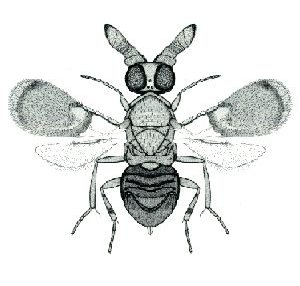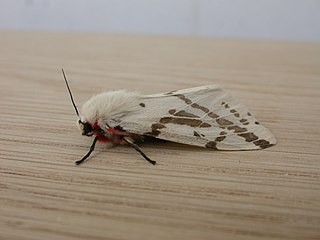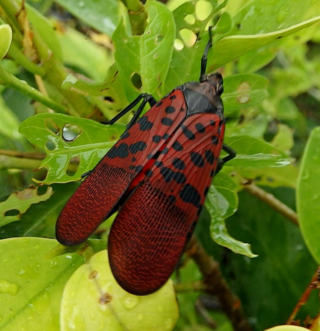
Chalcid wasps are insects within the superfamily Chalcidoidea, part of the order Hymenoptera. The superfamily contains some 22,500 known species, and an estimated total diversity of more than 500,000 species, meaning the vast majority have yet to be discovered and described. The name "chalcid" is often confused with the name "chalcidid", though the latter refers strictly to one constituent family, the Chalcididae, rather than the superfamily as a whole; accordingly, most recent publications (e.g.,) use the name "chalcidoid" when referring to members of the superfamily.

The family Fulgoridae is a large group of hemipteran insects, especially abundant and diverse in the tropics, containing over 125 genera worldwide. They are mostly of moderate to large size, many with a superficial resemblance to Lepidoptera due to their brilliant and varied coloration. Various genera and species are sometimes referred to as lanternflies or lanthorn flies, but neither do their heads emit light, nor are they even distantly related to flies.

The Mymarommatidae, sometimes referred to as false fairy wasps, are a very small family of microscopic parasitic wasps. Only about half of the known species are living taxa, but they are found worldwide.

Encyrtidae is a large family of parasitic wasps, with some 3710 described species in about 455 genera. The larvae of the majority are primary parasitoids on Hemiptera, though other hosts are attacked, and details of the life history can be variable. They are found throughout the world in virtually all habitats, and are extremely important as biological control agents. They may also present as an ecological threat to the population of some species. For example, the endangered Papilio homerus butterfly is parasitized at a rate of 77%, making them the main contributor to egg mortality in this butterfly species.
Polyembryony is the phenomenon of two or more embryos developing from a single fertilized egg. Due to the embryos resulting from the same egg, the embryos are identical to one another, but are genetically diverse from the parents. The genetic difference between the offspring and the parents, but the similarity among siblings, are significant distinctions between polyembryony and the process of budding and typical sexual reproduction. Polyembryony can occur in humans, resulting in identical twins, though the process is random and at a low frequency. Polyembryony occurs regularly in many species of vertebrates, invertebrates, and plants.

Ardices canescens, the dark-spotted tiger moth or light ermine moth, is a moth in the family Erebidae that is found across most of Australia. It originally was included in the genus Spilosoma, but later the generic status of Ardices was proven.

Oobius agrili is a parasitic non-stinging wasp of family Encyrtidae which is native to North Asia. It is a parasitoid of the emerald ash borer, an invasive species which has destroyed tens of millions of ash trees in its introduced range in North America. As part of the campaign against the emerald ash borer (EAB), American scientists in conjunction with the Chinese Academy of Forestry searched since 2003 for its natural enemies in the wild leading to the discovery of several parasitoid wasps, including Oobius agrili, which is a solitary egg parasitoid of EAB found on ash trees in Jilin province in 2004; it has been recorded to kill up to 60 percent of EAB eggs.

The spotted lanternfly is a planthopper indigenous to parts of China and Vietnam. It has spread invasively to Japan, South Korea, and the United States. Its preferred host is tree of heaven, but it infests crops including soybean, grapes, stone fruits, and Malus spp. In its native habitat, L. delicatula populations are regulated by parasitic wasps.

Encyrtinae is a subfamily of parasitic wasps in the family Encyrtidae.

Oobius is a parasitic non-stinging wasp genus in the family Encyrtidae.
Ooencyrtus marcelloi is a parasitic wasp belonging to the family Encyrtidae. The species was first discovered in 2008 in a tropical lowland rainforest in the Soberanía National Park around Gamboa, Panama. The scientific name was first published in 2010.
John Stuart Noyes is a Welsh entomologist.

Lycorma is a genus of planthoppers native to Asia. The first species within the genus was described by Frederick William Hope in 1843 and the genus was formally established by Carl Stål in 1863.

Ooencyrtus is a genus of chalcid wasp. William Harris Ashmead named and circumscribed the genus in 1900.
Neodusmetia sangwani is an encyrtid parasitoid from India that was used in classical biological control of the Rhodesgrass Scale, Antonina graminis (Maskell) (Pseudococcidae) which is a major pest of grasses outside of its native range in Asia. The parasitoid successfully controlled the scale infestation in Texas in the 1950s and 60s. It is considered among the most successful examples of classical biological control.
Anastatus orientalis is a species of parasitic wasp which preys on Lycorma lanternfly eggs. Females live significantly longer than males, over ten weeks compared to the male lifespan of three weeks.
Batkoa major is a naturally occurring fungus that infects insects.

Lycorma imperialis is a planthopper indigenous to parts of China and Indo-Malaysia. L. imperialis was originally discovered in 1846 by Adam White and has one recognized non-nominate subspecies, L. i. punicea. L. imperialis has undergone a number of reclassifications since its discovery and is one of four species in the genus Lycorma. L. imperialis follows a hemimetabolous life cycle and will undergo a series of nymphal stages (instars) before maturing to an adult.

Lycorma meliae is a planthopper species endemic to Taiwan, with multiple, dramatically different color morphs depending on the life stage. The species was described by Masayo Kato in Taiwan in 1929, and is the only member of its genus confirmed to be native to the island. In 1929, a specimen of L. meliae was originally described as a separate species, L. olivacea, also by Kato. These two taxon names were declared synonymous in 2023. L. meliae undergoes four instar stages before achieving adulthood and generally only survive until the winter.

Copidosoma koehleri belongs to the family Encyrtidae and genus Copidosoma within the order Hymenoptera. It is a parasitoid and its hosts are mainly potato tuber moth but it also infest Andean potato tuber moth, Guatemalan potato tuber moth and Tomato leafminer. Super-parasitism is associated with C. koehleri.












